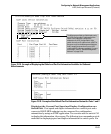
Configuring for Network Management Applications
LLDP (Link-Layer Discovery Protocol)
PoE Advertisements. These advertisements inform an LLDP-MED
endpoint of the power (PoE) configuration on switch ports. Similar
advertisements from an LLDP-MED endpoint inform the switch of the
endpoint’s power needs and provide information that can be used to identify
power priority mismatches.
Power-over-Ethernet TLVs include the following power data:
■ power type: indicates whether the device is a power-sourcing entity
(PSE) or a powered device (PD). A MED-capable VoIP telephone is a PD.
■ power source: indicates the source of power in use by the device. Power
sources for powered devices (PDs) include PSE, local (internal), and PSE/
local. The switches covered in this guide advertise Unknown.
■ power priority: indicates the power priority configured on the switch
(PSE) port or the power priority configured on the MED-capable end-
point.
■ power value: indicates the total power in watts that a switch port (PSE)
can deliver at a particular time, or the total power in watts that the MED
endpoint (PD) requires to operate.
To display the current power data for an LLDP-MED device connected to a
port, use the following command:
show lldp info remote-device < port-list >
For more on this command, refer to page 13-70.
To display the current PoE configuration on the switch, use the following
commands:
show power brief < port-list >
show power < port-list >
For more on PoE configuration and operation, refer to Chapter 11, “Power
Over Ethernet (PoE) Operation”.
Configuring Location Data for LLDP-MED Devices
You can configure a switch port to advertise location data for the switch itself,
the physical wall-jack location of the endpoint (recommended), or the
location of a DHCP server supporting the switch and/or endpoint. You also
have the option of configuring these different address types:
■ civic address: physical address data such as city, street number, and
building information
13-62


















